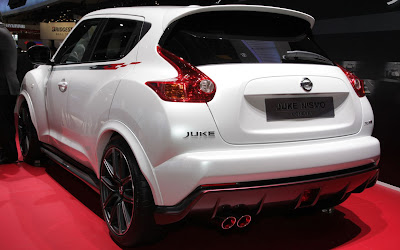Friday, September 27, 2013
2013 Nissan Juke Nismo
The wait is over - Nismo has arrived in Europe with the launch of the first in a new range of road cars: the Nissan Juke Nismo.
With track-derived design, enhanced performance and engaging handling, Nismos unique motorsport DNA adds a new dimension to the pioneering compact crossovers list of attributes.

2013 Nissan Juke Nismo

2013 Nissan Juke Nismo

2013 Nissan Juke Nismo

2013 Nissan Juke Nismo

2013 Nissan Juke Nismo

2013 Nissan Juke Nismo
Power comes from a modified version of Nissans acclaimed 1.6-litre direct-injection turbocharged petrol engine. You only need to look to the success of the pioneering Nissan DeltaWing to see the potential of this advanced and efficient engine...
Add a bespoke aerodynamics package and revised chassis design and you have a driving experience which takes Juke thrills to the next level. Two models - front-wheel-drive with a six-speed manual transmission and an all-wheel drive with CVT and 7-speed manual mode - are available, with every Nissan Juke Nismo benefitting from a motorsport-inspired interior packed with innovative technology.
Andy Palmer, Nissans Executive Vice President, Global Product Planning, commented: "Nismo is about providing innovation and excitement for everyone, and theres no better place to start than with the Juke, our critically acclaimed and highly successful compact crossover. Oozing an attitude that has really struck a chord with buyers across Europe, it was the obvious choice for the Nismo team to showcase its design, engineering and personalisation expertise."
After initially appearing as a concept at the 2011 Tokyo Motor Show, the Nissan Juke Nismo made its global debut in production form at the Le Mans 24-Hour Race in June 2012. It was seen again at the 2012 Paris Motor Show in September and is on sale now.
The Nissan Juke Nismo is the product of global expertise. Its design and engineering was led by Nissan and Nismo in Japan in partnership with Nissan Design Europe (NDE) in London, UK, and Nissan Technical Centre Europe (NTCE), in Cranfield, UK. Like other Juke models, the Juke Nismo will be built at Nissans UK manufacturing facility in Sunderland.
Nissan Connect with enhanced functionality
The Nissan Juke Nismo is among the first Nissans to feature an enhanced version of the Nissan Connect infotainment system. Already an enormously successful system, Connect continues to offer an exceptional package of navigation and connectivity in one standard fit, integrated package.
Benefitting from a larger 5.8-inch touch-screen display, the latest system includes Google Send to Car navigation software allowing routes planned at home to be transferred directly to the car. Additional connected services include Google Points of Interest (POI), nearest fuel prices, plus flight and weather information. Enhanced satellite navigation functionality also includes exit view and lane guidance, in addition to the full Bluetooth connectivity and reversing camera systems that Connect users have come to rely on.
NDCS Nissan Dynamic Control System (NDCS)
The Nissan Juke Nismo offers further control through Nissan Dynamic Control System (NDCS). This advanced central command system allows the driver to alter the cars dynamic settings as well as make changes to everyday functions including climate control.
The centrally mounted digital screen changes display, colour and functions depending on the mode selected by the driver. Settings alter throttle maps, steering effort and CVT shift schedules on the 4WD Nissan Juke Nismo.
In the D-Mode Sport setting, the throttle map is retuned to deliver higher engine revs and sharper responses, while in the Eco setting, engine revs are reduced for more gentle progress. In the M-CVT version of the DIG-T engine Juke, the Sport setting even introduces a rhythmic auto up shift that simulates manual changes at the red-line.
Steering effort in Sport is firmer and more responsive, while in Normal its lighter and more linear. In the Eco setting, the quantity of cold air circulating in the cabin is optimised, reducing the load on the climate control and lowering the systems power consumption.
Real time trip information can also be displayed giving average speed, fuel economy, journey times and engine torque and turbo boost as well as a daily fuel consumption history. The system even incorporates a G-Force indicator.
Articles Source : NetCarShow